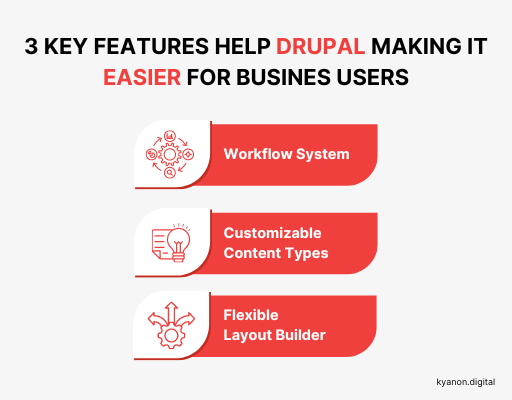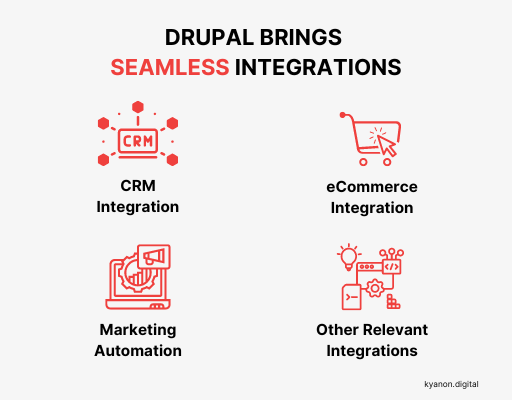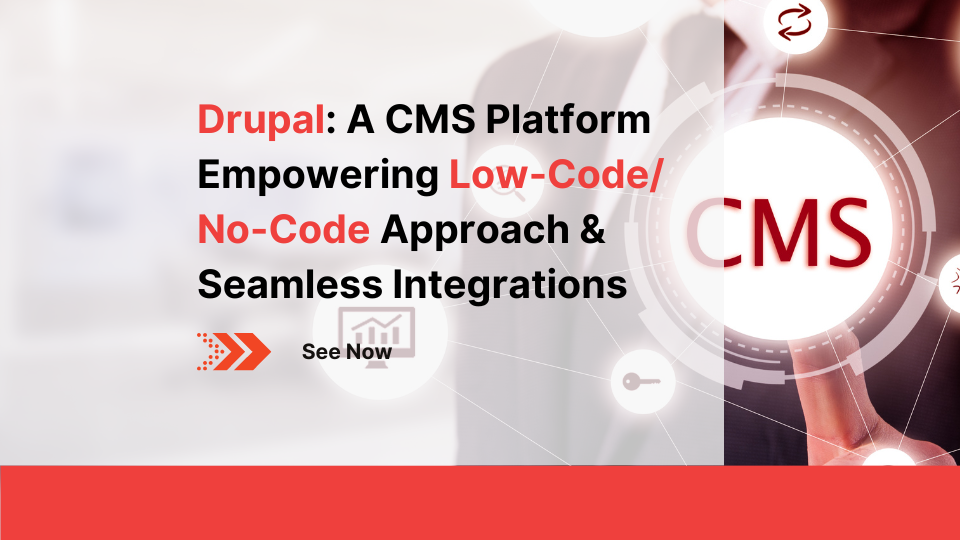Drupal is an excellent content management system (CMS) known for its flexibility, capabilities and extensibility.In order to highlight the benefits of Drupal for your organization, we will focus on two key points:

 Drupal’s easy-to-use approach, with minimal coding requirements, makes it a powerful choice for building websites and applications. Moreover, its seamless integration capabilities with CRM systems, eCommerce platforms, marketing automation tools, and more, provide organizations with a unified and comprehensive solution. By choosing Drupal as their CMS platform, businesses can create compelling digital experiences, drive growth, and stay ahead in the competitive digital landscape while having a solution that is scalable and secure.Kyanon Digital hopes that you have gained a comprehensive overview of Drupal: a CMS platform empowering low-code/no-code approach and seamless integrations through this article. If you have any questions related to this matter, do not hesitate to contact us for specific consultation.
Drupal’s easy-to-use approach, with minimal coding requirements, makes it a powerful choice for building websites and applications. Moreover, its seamless integration capabilities with CRM systems, eCommerce platforms, marketing automation tools, and more, provide organizations with a unified and comprehensive solution. By choosing Drupal as their CMS platform, businesses can create compelling digital experiences, drive growth, and stay ahead in the competitive digital landscape while having a solution that is scalable and secure.Kyanon Digital hopes that you have gained a comprehensive overview of Drupal: a CMS platform empowering low-code/no-code approach and seamless integrations through this article. If you have any questions related to this matter, do not hesitate to contact us for specific consultation.
- Drupal’s user-friendly approach that requires little to no coding in order to build complex web application workflow driven.
- Its ability to integrate with various systems like CRM, Salesforce, eCommerce platforms (such as Magento), marketing automation tools (like Mautic) and others.
Table of contents
show
1. Easy Customization with Minimal Coding
Drupal follows the low-code/no-code trend, making it easier for business users to build powerful websites and applications without extensive coding knowledge. It is achieved thanks to three key features.
1.1. Workflow System
Drupal’s customizable workflow system simplifies content creation and publication. The easy to use interfaces do not require you to be a tech whiz to define custom workflows and automate content approval processes. The system offers a drag-and-drop interface, allowing administrators to design workflows that suit their needs. This ensures efficient content management and collaboration with an agile mindset making changes smooth and easy to integrate.1.2. Customizable Content Types
Drupal provides a user-friendly interface for creating custom content types. A content type can be seen as a definition of a data structure. This means content authors can design dynamic, structured content without getting caught up in complex programming. With Drupal’s intuitive configuration options, organizations can tailor content types to their specific needs, enhancing the overall user experience and once again making evolution requests easy to take into account.1.3. Flexible Layout Builder
In addition to customizable workflows and content types, Drupal’s Layout Builder allows business users to visually construct and arrange page layouts without coding. This powerful tool gives content creators the freedom to design complex page structures, move elements around, and add customized blocks. This feature does not require technical skills such as CSS or HTML, therefore business users can really take control of the website’s layout and design, reducing the need for extensive development work and an accelerated time to market.Also, thanks to A/B testing capabilities, Drupal will help you to assess quickly which UI is the most efficient and those also with a no code approach.In summary, Drupal embraces a no code / low code approach for the workflows, the data structure managed and the UI. Nevertheless, these elements would be nothing without the numerous plugins and modules that can transform Drupal as a core application for your system thanks to its seamless integrations.2. Seamless Integrations
Drupal’s plugin ecosystem enables seamless integration with various external systems, expanding its functionality and providing organizations with a comprehensive solution. Let’s explore some relevant integration options and which benefits it can bring.
2.1. CRM Integration
Drupal seamlessly integrates with Customer Relationship Management (CRM) systems like Salesforce or Odoo. This integration allows organizations to synchronize user data, automate lead generation, and deliver personalized experiences based on CRM insights. With Drupal’s native capabilities and CRM integration modules, businesses can create powerful customer-centric experiences without diving deep into coding. It allows business users to personalize content based on the history of each customer and to maximize the average revenue per user whether when your organization is selling services or products, in particular via an eCommerce platform.2.2. eCommerce Integration
Drupal’s flexibility provides natively some eCommerce capabilities and in addition allows it to integrate smoothly with popular eCommerce platforms like Magento. By adding to Drupal’s content management capabilities eCommerce features, organizations can create engaging shopping experiences, manage product catalogs, and leverage advanced marketing tools, all within a unified platform. This integration simplifies backend operations while delivering exceptional online shopping experiences especially when integrated as well with your CRM as explained before.2.3. Marketing Automation
Drupal can also integrate with marketing automation systems on premise or on Saas. This integration enables organizations to leverage powerful marketing capabilities. By syncing user data, tracking behavior, and personalizing content, Drupal and Marketing Automation solutions facilitate targeted marketing campaigns, lead nurturing, and customer engagement. This integration empowers businesses to optimize their marketing efforts and drive conversions while still requiring almost to no code.Thanks to Drupal the time between the initiating of a Marketing Campaign and its go-live is a matter of days, if not hours.2.4. Other Relevant Integrations
Apart from the aforementioned integrations, Drupal offers an extensive array of plugins and modules to connect with various other systems. Whether it’s email marketing platforms, analytics tools, social media platforms, or payment gateways, Drupal provides compatibility and flexibility to connect with a wide range of third-party services. This allows organizations to build comprehensive and interconnected digital ecosystems.Finally it is worth mentioning that it is possible to enrich this catalog of extensions and to add new capabilities on demand thanks to its rich and well documented API.3. Compared to WordPress
While WordPress remains a popular choice for websites, choosing, or migrating, to Drupal offers distinct advantages.First of all, Drupal is renowned for its scalability and flexibility, making it an ideal platform for websites with complex requirements. As organizations grow, their websites often demand more advanced features and customization options. Drupal’s architecture and modular approach allow for greater scalability, enabling businesses to handle increasing traffic, content, and functionality without compromising performance.Furthermore, Security is a critical aspect of any website, and Drupal has a reputation for prioritizing it. The Drupal community actively monitors and addresses security vulnerabilities, providing regular updates and patches. The platform’s built-in security features, such as robust access controls and user permissions, help safeguard websites from potential threats. Migrating to Drupal can offer organizations peace of mind and a higher level of protection for their digital assets.Finally, in addition to its extensive plugin ecosystem and seamless integrations, even though both WordPress and Drupal have thriving communities, Drupal’s community is known for its technical expertise and enterprise focus. Drupal’s dedicated community actively contributes to the platform’s development, ensuring continuous improvements and a wealth of resources, including documentation, forums, and support channels.4. Conclusion
 Drupal’s easy-to-use approach, with minimal coding requirements, makes it a powerful choice for building websites and applications. Moreover, its seamless integration capabilities with CRM systems, eCommerce platforms, marketing automation tools, and more, provide organizations with a unified and comprehensive solution. By choosing Drupal as their CMS platform, businesses can create compelling digital experiences, drive growth, and stay ahead in the competitive digital landscape while having a solution that is scalable and secure.Kyanon Digital hopes that you have gained a comprehensive overview of Drupal: a CMS platform empowering low-code/no-code approach and seamless integrations through this article. If you have any questions related to this matter, do not hesitate to contact us for specific consultation.
Drupal’s easy-to-use approach, with minimal coding requirements, makes it a powerful choice for building websites and applications. Moreover, its seamless integration capabilities with CRM systems, eCommerce platforms, marketing automation tools, and more, provide organizations with a unified and comprehensive solution. By choosing Drupal as their CMS platform, businesses can create compelling digital experiences, drive growth, and stay ahead in the competitive digital landscape while having a solution that is scalable and secure.Kyanon Digital hopes that you have gained a comprehensive overview of Drupal: a CMS platform empowering low-code/no-code approach and seamless integrations through this article. If you have any questions related to this matter, do not hesitate to contact us for specific consultation.
5/5 - (1 vote)



